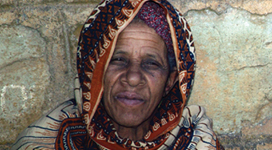
Ethiopian Jews
For centuries, the Beta Israel of Gondar, the Beta Abraham of Addis Ababa, and the Gefat of Woliso and Hosanna have endured persecution for their felasha or “foreigner” status among Ethiopians. Many believe they are from the tribe of Dan. Thousands were rescued from poverty and brought to Israel during the massive airlifts of 1984, 1985, and 1991. The aliyah (return of the Jews to their homeland) program sponsored by Israel has been stopped and resumed a number of times since then. Only those Jewish people who have not converted to another religion and are considered by authorities to remain solely Jewish in their faith are permitted to make aliyah. We know of many thousands of people who belong to small tribal groups and we are continuing to reach out to them with the love of their Jewish Messiah.

Yibir of Somaliland
The origin of the Yibir is unclear. It is one of the oldest ethnic groups in Somaliland and is said to predate Islam in the area. They are known as highly secretive of their language, not letting members of other ethnic groups around them even hear them speak it. Some suggest they came from the Beta Israel of Ethiopia, and are, therefore, also believed to be from the tribe of Dan, having made their way into Somaliland. While it remains disputed and uncertain, the Yibir do have some things in common with the Beta Israel, namely their outcast status in their countries and metal working trades. They have not sought to make themselves known to Israel and Jewish officials because it would create more problems for the Yibir people who already endure a despised position among their countrymen.

B'nei Menashe of India
When the Bnei Menasha Jews of India were “found,” they called themselves Israelites, rather than Jews, and they claim the tribe of Manasseh. After the Assyrian conquest, some of Israel’s people of the Northern Kingdom followed the Silk Route into China. The Silk Route was a 4,000-mile-long road system developed for commerce between China and the Middle East. Some believe that, after settling in China, some Jewish people migrated south into the northern regions of India. Some of the Bnei Menashe dispute this, saying they do not have the same customs as the Chinese. They remember their fathers sacrificing an animal, taking the blood, and painting it onto the doorposts at Passover.

Lemba of Zimbabwe
The Lemba are believed to have fled Jerusalem after the Temple was destroyed around 586 BC. Though not among the traditionally described Ten “Lost Tribes of Israel,” these Jewish people were scattered when the Southern Kingdom of Judah fell to Babylonia. It is believed they fled Judea and ended up in Yemen. From Yemen they migrated to Africa, eventually settling in Ethiopia and Tanzania. Many left Ethiopia, moved south to Zimbabwe and became known as the Lemba. Seventy percent of the Lemba have tested to possess Cohanim DNA, lending credibility to their claim of ties to the ancient people of Israel, particularly the Levites.

Lost and Found…to us
The history of the ”Lost Tribes” is fascinating, and we rejoice in being a part of reaching and gathering these scattered people back to Israel – and more importantly, back to God through Yeshua. We’ve seen firsthand that God is reconciling them to Himself in extraordinary numbers!



